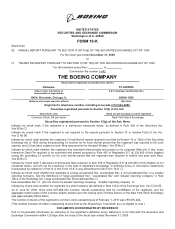Boeing 2009 Annual Report Download - page 21
Download and view the complete annual report
Please find page 21 of the 2009 Boeing annual report below. You can navigate through the pages in the report by either clicking on the pages listed below, or by using the keyword search tool below to find specific information within the annual report.On Commercial Airplanes development programs our ability to sell test aircraft or initial units produced
can also affect our results. For example in 2009 we determined that three of the 787 flight test aircraft
could not be sold. This resulted in $2.7 billion being accounted for as research and development
expense as opposed to being capitalized as inventory. Our inability to sell additional test aircraft could
increase future research and development expenses.
We enter into cost-type contracts which also carry risks.
Approximately 50% of BDS revenues are generated from cost-type contracting arrangements. Some of
these are development programs that have complex design and technical challenges. These cost-type
programs typically have award or incentive fees that are subject to uncertainty and may be earned over
extended periods. In these cases the associated financial risks are primarily in lower profit rates or
program cancellation if cost, schedule or technical performance issues arise. Programs whose
contracts are primarily cost-type include GMD, BCTM (formerly FCS), P-8A Poseidon, Proprietary
programs, Airborne Laser, JTRS, FAB-T and the EA-18G Growler.
We enter into contracts that include in-orbit incentive payments that subject us to risks.
Contracts in the commercial satellite industry and certain government satellite contracts include in-orbit
incentive payments. These in-orbit payments may be paid over time after final satellite acceptance or
paid in full prior to final satellite acceptance. In both cases, the in-orbit incentive payment is at risk if the
satellite does not perform to specifications for up to 15 years after acceptance. The net present value
of in-orbit incentive fees we ultimately expect to realize is recognized as revenue in the construction
period. If the satellite fails to meet contractual performance criteria, customers will not be obligated to
continue making in-orbit payments and/or we may be required to provide refunds to the customer and
incur significant charges.
We use estimates in accounting for many contracts and programs. Changes in our estimates
could adversely affect our future financial results.
Contract and program accounting require judgment relative to assessing risks, estimating revenues
and costs and making assumptions for schedule and technical issues. Due to the size and nature of
many of our contracts and programs, the estimation of total revenues and cost at completion is
complicated and subject to many variables. Assumptions have to be made regarding the length of time
to complete the contract or program because costs also include expected increases in wages, material
prices and allocated fixed costs. Incentives or penalties related to performance on contracts are
considered in estimating sales and profit rates, and are recorded when there is sufficient information
for us to assess anticipated performance. Suppliers’ assertions are also assessed and considered in
estimating costs and profit rates. Estimates of award fees are also used in sales and profit rates based
on actual and anticipated awards.
Under program accounting, inventoriable production costs (including overhead), program tooling costs
and routine warranty costs are accumulated and charged as cost of sales by program instead of by
individual units or contracts. A program consists of the estimated number of units (accounting quantity)
of a product to be produced in a continuing, long-term production effort for delivery under existing and
anticipated contracts limited by the ability to make reasonably dependable estimates. To establish the
relationship of sales to cost of sales, program accounting requires estimates of (a) the number of units
to be produced and sold in a program, (b) the period over which the units can reasonably be expected
to be produced and (c) the units’ expected sales prices, production costs, program tooling and routine
warranty costs for the total program. Several factors determine accounting quantity, including firm
orders, letters of intent from prospective customers and market studies. Such estimates are
9
























